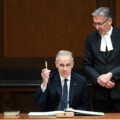In the post-pandemic world, health spending in Canada continues to be marked by the paradox of simultaneous feast and famine, according to the Canadian Institute for Health Information (CIHI) release of the National Health Expenditure Trends 2023.
Total health spending in Canada for 2023 is projected at $343.8 billion, up 2.8 percent from 2022. The lingering effects of the pandemic contributed to growth in hospital expenditures of 11 percent in 2022 and 4 percent in 2023. Meanwhile, physician spending grew almost 10 percent in 2022 and nearly 7 percent in 2023. As a share of GDP, health spending’s projected share of GDP in 2023 is approximately the same as the previous year, at about 12 percent which is still above the pre-pandemic figure of 11 percent.
However, despite what seems to be robust overall growth numbers, once one factors in population growth as well as inflation, it turns out that real per capita health spending in Canada is expected to be down for the second year in a row. Indeed, for 2023, the change in real total health spending per capita is -0.5 percent which comes after a nearly 2 percent decline the previous year. However, it remains that real per capita spending is still substantially higher than it was going into the pandemic.

Figure 1 provides some historical perspective on the long ascent of real per capita health spending in Canada providing a plot not only of total spending but also provincial government and private sector health spending. The pre-pandemic period saw a slowdown in the growth rate of real per capita spending, which was more pronounced at the provincial government level.
From 2010 to 2019, the average annual growth rate for total real per capita spending was 1.2 percent, but provincial government spending grew at 1.1 percent while private spending grew at 1.6 percent. By way of comparison, during the heyday of the federal transfer escalator, the 2000 to 2010 period saw average annual growth in real per capita total health spending of 3.2 percent—3.3 percent for provincial government and 3.1 percent for private.
The pandemic, fueled by emergency federal health transfers, saw real per capita public sector health spending surge, but also a decline in private sector. Figure 2 dramatically illustrates the 2020 surges in real per capita health spending for total and provincial government health, which each clocked in at about 8 percent respectively, but this was accompanied by a nearly 8 percent drop in private spending. The next year, provincial government spending grew at a slower but still robust rate at 4.7 percent, but real per capita private health spending rebounded at 8 percent and total health spending at 4.9 percent. For the subsequent two years however, decline sets in for real per capita total health spending at -3.9 and -0.5 percent driven mainly by declining provincial government spending at -2.2 and -0.5 percent given that private spending rose at 1.8 and 2.2 percent. However, this decline in per capita spending was partly driven by the wind-up of COVID-19 supports as well as other public health spending.

It should be noted that for 2023, real per capita provincial government health spending is projected at $5,723. If after 2019 spending had continued to increase at the same average rate from 2010 to 2019, then 2023 would clock in at approximately $5,450 which means that real per capita health spending in 2023 is still projected at several hundred dollars above what the previous trends might have placed it at. Indeed, compared to 2019, real per capita provincial government health spending in Canada is 10 percent higher. Overall, despite the recent declines due to both a winding up of pandemic-specific health spending as well as robust population growth, it would appear that there has been an enrichment of per-person health spending.
However, performance varies across health spending categories. In the case of provincial government health spending, for 2023 the largest components are hospitals (36 percent), physicians (20 percent), other institutional care including LTC homes (14 percent), and provincial drug plan spending (7 percent). If one looks at a comparison of real per capita provincial government spending between 2019 and 2023 for these key categories, hospital spending is up 6 percent, other institutions is up 25 percent, physicians is up 1.3 percent, but drugs is down nearly 2 percent. As for some of the other categories, real per capita provincial government public health over the same period is up 29 percent, other professionals at 10 percent, administration is up 9 percent, and home care/community care is up 14 percent.

So, what is one to make of all this in the current context of waiting lists and health care shortages that continue to plague health systems across Canada? Despite the post-pandemic decline in emergency health spending and the resulting slowdown in real per capita health spending growth for 2022 and 2023, it remains that real per capita health spending is up substantially. But two areas still lag the others: physician spending and drugs. Drug spending by provincial drug plans is linked to physician spending: if people cannot access physicians because of shortages in family doctors, then they are also going to find it more difficult to fill their prescriptions.
Of course, the Canadian health spending paradox of more spending and yet growing issues of access and timely service delivery is not a new one. It has, however, entered a more concerning phase given that physicians are the primary gatekeepers when it comes to health care access. If large proportions of provincial populations are not able to access physician services and get in line for care, how exactly are all these spending increases going to meet the health-care needs of Canadians?
For the time being, provincial health-care systems appear to be dealing with access issues by changing the access rules to some health services. Take the case of Ontario. Pharmacists in Ontario can now prescribe treatments for nineteen health services including diaper rashes, canker sores, and yeast infections. And most recently, Ontario has expanded the ability to self-refer for screening tests by lowering the age for women’s breast screening without a doctor’s referral to 40. One expects that eventually you may be able to self-refer for other routine screening tests in order to free up scarce physician time.
While such measures are a way of dealing with current physician shortages by reducing some of their gatekeeping requirements, it remains that they are short-term stop-gap measures. Eventually, once results from self-referred tests come back and short-term pharmacy treatments are exhausted, people will still need to see a doctor. Expect to see within a year or two complaints that despite a test result requiring follow-up, people cannot get in to see a physician. The next health-care accessibility crisis is already taking shape.
Recommended for You

Daniel Zekveld: Age verification for pornography is not government overreach

Chris Spoke and Peter Copeland: Ontario is missing millions of homes. Here’s where the government is failling—and how it can actually make a meaningful difference

‘The cost of permitting has ballooned’: Sharon Singh on Canada’s broken regulatory system

Sean Speer: Pierre Poilievre is right to favour pro-worker policies over increasing immigration




